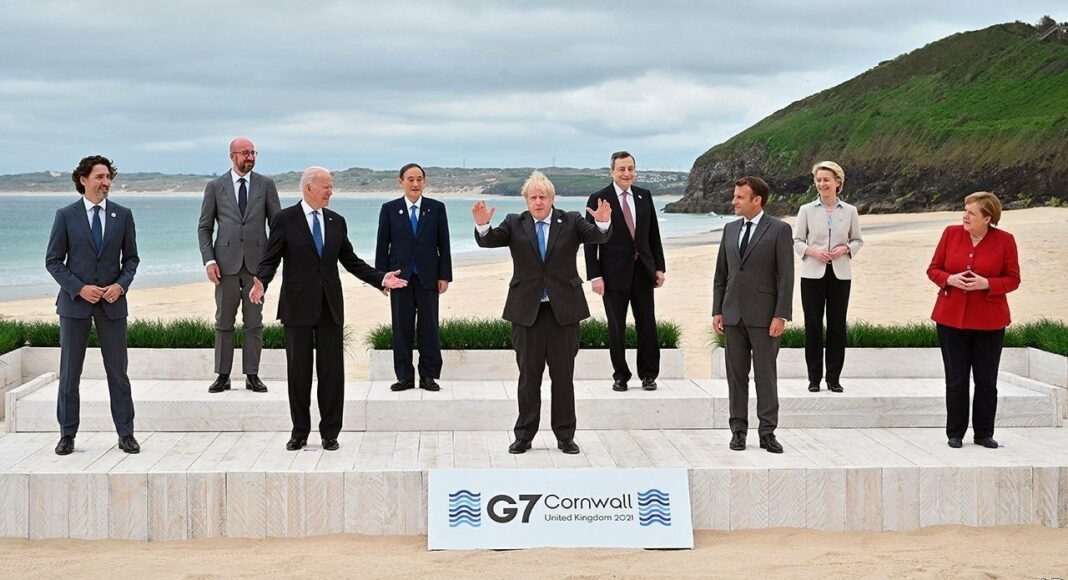Jun 12th 2021
JOE BIDEN believes that America and its rich allies must offer poor countries an attractive alternative to Chinese loans and investment. It is not enough, he thinks, just to put pressure on them to spurn business with Beijing, the approach many argued was taken under Donald Trump. Today the White House said Mr Biden and his G7 counterparts have agreed to form a multilateral rival to China’s Belt and Road Initiative that would offer such an alternative, at least in theory. The Biden administration is trying to sell it as an ambitious programme to build hundreds of billions of dollars’-worth of infrastructure in the developing world on friendlier, greener and more transparent terms than China offers. But there is much less here than meets the eye.
Mr Biden says he broached the idea of a multilateral alternative to the Belt and Road on a telephone call with Boris Johnson in March. It is easy to see why. Mr Biden has made a point of courting European allies, in contrast to his predecessor. And there are few things more bipartisan and popular in Washington these days than finding ways to stick it to China. The G7 partnership, called “Build Back Better World” or B3W, would, in concept, finance projects that are better for their countries and the world than some China has pushed, including dirty coal-fired power plants, dams that disrupt communities and expensive ports and railways that saddle countries with debt. A more generous flow of Western development money could help countries resist the temptations of Chinese lending and investment.
But B3W appears to lack oomph to match the ambitious rhetoric. There is no overarching new structure to push it. Nor is it clear that Mr Biden or other G7 leaders will seek or be able to extract substantial additional funding from their governments (A senior Biden official says the administration intends to work with Congress to improve the “development-finance toolkit”). And it is unclear what projects would be pursued that are not already seeking support or under consideration. A long and expensive backlog of green-infrastructure projects in poor countries, promised as part of the Paris climate accords, already awaits financing. The president’s plan may amount to little more than a rebranding or repurposing of existing development capital.
Indeed finding the money, as opposed to the words, to stick it to China will be a challenge. Mr Johnson is cutting his foreign-aid budget. Mr Biden is struggling to get Republican votes for domestic infrastructure spending, despite his claim that investing on the homefront is important to America’s competition with China. On June 9th Mr Biden said America would donate 500m coronavirus vaccine doses to the developing world with “no strings attached” and without “pressure for favours” in return, implying China’s vaccine diplomacy is cynically transactional. But the donation, though matched by the rest of the G7 for a total of 1bn vaccines, is meagre compared with the need (see leader). On June 8th the Senate passed a bill calling for investments in science and technology that its backers say will help America stay ahead of China, but those outlays too were scaled back. One part of the bill that remained intact was a call for hundreds of millions of dollars annually to counter Chinese influence and propaganda.
The Biden administration and other rich democracies can support more projects in the developing world even without a huge influx of capital. They can do more to lower financing costs for developing countries, including by proing guarantees on commercial loans. Offering seed capital and risky tranches of loans may also spur private investment. This kind of “blended finance” will come in America from the US International Development Finance Corporation (a Trump-era successor to the Overseas Private Investment Corporation).
In that sense “Build Back Better World” is a spectral mirror image of the Belt and Road Initiative itself. BRI is an umbrella term for a wide range of projects totalling hundreds of billions of dollars, some initiated before the label existed in 2013, others advanced opportunistically by companies (many of them state-owned) seeking to profit from the ambitions of Xi Jinping, China’s leader. But unlike the Communist Party, the G7 governments cannot strong-arm companies to pursue projects.
B3W may prove to have most in common with BRI as a propaganda element in the struggle between China and America for middle countries’ affections. (With Mr Trump out of office, there is no contest in rich democracies; Mr Biden is widely trusted and Mr Xi is deeply distrusted, according to a survey released on June 10th by Pew Research Centre.) More than 100 countries in the global South have struck deals with China under Belt and Road. Many of these have led to debt restructurings and, occasionally, to recriminations about predatory lending. But in recent years China has often been the easy option for poor countries seeking financing. Many would welcome an alternative source. The G7 has a lot more work to do to show that B3W is a real one.



